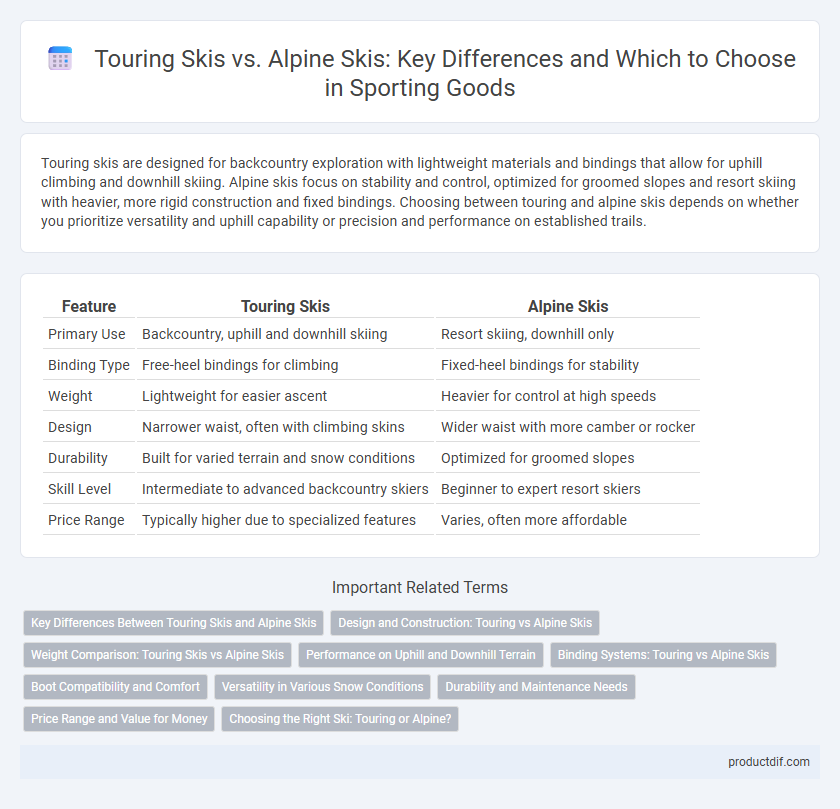Touring skis are designed for backcountry exploration with lightweight materials and bindings that allow for uphill climbing and downhill skiing. Alpine skis focus on stability and control, optimized for groomed slopes and resort skiing with heavier, more rigid construction and fixed bindings. Choosing between touring and alpine skis depends on whether you prioritize versatility and uphill capability or precision and performance on established trails.
Table of Comparison
| Feature | Touring Skis | Alpine Skis |
|---|---|---|
| Primary Use | Backcountry, uphill and downhill skiing | Resort skiing, downhill only |
| Binding Type | Free-heel bindings for climbing | Fixed-heel bindings for stability |
| Weight | Lightweight for easier ascent | Heavier for control at high speeds |
| Design | Narrower waist, often with climbing skins | Wider waist with more camber or rocker |
| Durability | Built for varied terrain and snow conditions | Optimized for groomed slopes |
| Skill Level | Intermediate to advanced backcountry skiers | Beginner to expert resort skiers |
| Price Range | Typically higher due to specialized features | Varies, often more affordable |
Key Differences Between Touring Skis and Alpine Skis
Touring skis are designed for uphill travel with lightweight construction and bindings that allow the heel to lift, enabling efficient climbing and backcountry exploration. Alpine skis focus on downhill performance, featuring heavier build and fixed-heel bindings for stability and control on groomed slopes. The key difference lies in touring skis' versatility for uphill and downhill, while alpine skis prioritize precision and power on descents.
Design and Construction: Touring vs Alpine Skis
Touring skis feature lightweight construction with integrated bindings designed for uphill efficiency and easy maneuverability in varied terrain, often incorporating climbing skins for grip. Alpine skis prioritize robust materials and stiffer flex patterns to provide stability and precision on groomed slopes, with heavier bindings optimized for downhill performance. The design differences reflect each ski type's focus: touring skis balance weight reduction and durability for backcountry travel, while alpine skis emphasize control and power for downhill speed.
Weight Comparison: Touring Skis vs Alpine Skis
Touring skis are significantly lighter than alpine skis, typically weighing between 2 to 4 kilograms per pair, which enhances uphill efficiency and reduces fatigue during extended backcountry trips. Alpine skis generally weigh more, ranging from 3 to 5 kilograms per pair, as they are designed for durability and stability in downhill performance. The lightweight construction of touring skis often incorporates materials like carbon fiber and lightweight alloys, optimizing weight savings without sacrificing strength.
Performance on Uphill and Downhill Terrain
Touring skis excel in uphill performance due to their lightweight construction and compatibility with climbing skins, enhancing grip and efficiency on steep ascents. Alpine skis offer superior downhill performance with their heavier, stiffer design, providing greater stability, edge control, and power on groomed slopes and variable terrain. Selecting between touring and alpine skis largely depends on prioritizing uphill mobility or downhill precision in varied mountain conditions.
Binding Systems: Touring vs Alpine Skis
Touring skis feature specialized binding systems that allow the heel to lift for uphill climbing and secure down for downhill skiing, providing versatility and mobility in backcountry terrain. Alpine ski bindings are designed for fixed-heel control, optimized for stability and performance on groomed slopes and high-speed descents. The key difference lies in touring bindings' lightweight construction and adjustable release mechanisms compared to the more robust, rigid alpine bindings built for precision and safety in aggressive downhill skiing.
Boot Compatibility and Comfort
Touring skis require specialized boots designed for uphill mobility with a flexible sole and a walk mode, ensuring comfort during long ascents and varied terrain. Alpine skis use rigid, supportive boots optimized for downhill performance, offering maximum control and stability but less comfort for walking. Choosing between the two depends on the balance between mobility and downhill precision desired by the skier.
Versatility in Various Snow Conditions
Touring skis excel in versatility by offering lightweight construction and climbing skins, enabling efficient uphill travel and adaptability to diverse snow conditions, from powder to hardpack. Alpine skis prioritize downhill performance with rigid designs and optimized edges, providing superior control on groomed slopes but less flexibility for varied terrain. Choosing touring skis enhances exploration opportunities in backcountry and variable snow, while alpine skis deliver precision and stability on established runs.
Durability and Maintenance Needs
Touring skis are designed with lightweight materials to enhance uphill performance, which can result in reduced durability compared to alpine skis that prioritize robustness for high-speed downhill stability. Alpine skis typically require less frequent maintenance due to their reinforced construction and durable edges, while touring skis demand more regular tuning and edge care to maintain optimal performance across varied terrains. Proper upkeep extends the lifespan of both types, but alpine skis generally offer greater resilience under harsher conditions and aggressive use.
Price Range and Value for Money
Touring skis typically range from $400 to $900, offering excellent value for backcountry enthusiasts who prioritize lightweight gear and versatility over price. Alpine skis tend to cost between $300 and $800, delivering solid performance and durability on groomed slopes, making them a cost-effective choice for frequent resort skiers. Buyers seeking the best value should consider their skiing style and terrain preferences to match the ski type with their budget efficiently.
Choosing the Right Ski: Touring or Alpine?
Choosing the right ski depends on your intended use: touring skis offer lightweight construction and climbing skins compatibility for backcountry exploration and uphill travel, while alpine skis provide stability and control for downhill performance at ski resorts. Touring skis prioritize maneuverability and efficiency on varied terrain, making them ideal for long-distance adventures and remote areas. Alpine skis feature heavier builds and stronger bindings designed to maximize speed and precision on groomed slopes and challenging descents.
Touring Skis vs Alpine Skis Infographic

 productdif.com
productdif.com